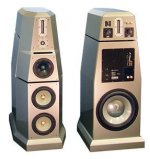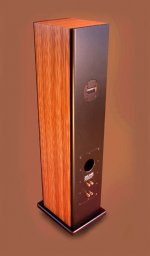you know there's not a single thread on these????
what are the pros and cons of an ambience tweeter rear firing in a speaker tower?
how would one impliment this?
it's a very rare design to see in high end audio
what are the pros and cons of an ambience tweeter rear firing in a speaker tower?
how would one impliment this?
it's a very rare design to see in high end audio
The sound is hard to describe. I guess one could say a wider stage. I used a cone tweeter in the rear and a dome in front. I crossover the cone tweeter just a little lower than the dome,then adjusted the volume on the cone until I was happy with the level.
It would be a good idea to use a l-pad and a off on switch on the rear tweeter.
It would be a good idea to use a l-pad and a off on switch on the rear tweeter.
Here are some high end designs that use rear firing tweeters/ribbons:
HGP Lyra SoNova
Triangle Stratos Australe
Triangle Stratos Volante
Triangle Stratos Magellan
Von Schweikert Audio VR-9SE (see pic)
Von Schweikert Audio DB-99 MK II
Von Schweikert Audio VR-11 XTC
North Creek Music Manifest
HGP Lyra SoNova
Triangle Stratos Australe
Triangle Stratos Volante
Triangle Stratos Magellan
Von Schweikert Audio VR-9SE (see pic)
Von Schweikert Audio DB-99 MK II
Von Schweikert Audio VR-11 XTC
North Creek Music Manifest
Attachments
michaelpage26 said:Here are some high end designs that use rear firing tweeters/ribbons:
HGP Lyra SoNova
Triangle Stratos Australe
Triangle Stratos Volante
Triangle Stratos Magellan
Von Schweikert Audio VR-9SE (see pic)
Von Schweikert Audio DB-99 MK II
Von Schweikert Audio VR-11 XTC
North Creek Music Manifest
that's a very beautiful speaker...
good call with the on off switch....
should an ambience tweeter be the same tweeter as the front? or should it be smaller/larger...?
the Wilson Alexandria uses a 3/4" supertweeter for ambience... so should it be more efficent/powerful than the front?
jaudio said:
It would be a good idea to use a l-pad and a off on switch on the rear tweeter.
Parts express was selling input terminals with bi-amp inputs, a switch and an L-pad in one "cup".
They were dirt cheap so I bought 4-6 of them just to try out this very idea.
Maybe you can find some of those to try it out.
Audiophilenoob said:
should an ambience tweeter be the same tweeter as the front? or should it be smaller/larger...?
Normally yes but not always. The reasonl I used the cone tweeter is it had a lower crossover point,so I got more midrange
Audiophilenoob said:
the Wilson Alexandria uses a 3/4" supertweeter for ambience... so should it be more efficent/powerful than the front?
Equal to or less that why it is a good idea to use a L-pad
I don't have any experience with ambience tweeters, but it seems that the front firing tweeter is larger or the same size compared to the rear firing. One example is the North Creek Music Manifest. It uses for front firing tweeters the Aurum Cantus G1s while for ambience tweeters it uses the smaller Aurum Cantus G2is. Also an intresting note is that the ambience tweeter is mounted horizontally (see pic)!
P.S. I didn't know that the Wilson X-2 Alexandrias had ambience tweeter!
P.S. I didn't know that the Wilson X-2 Alexandrias had ambience tweeter!
Attachments
my question is this... Do you use them as normal or reversed polarity? Bipole, or Dipole that is...
Does it matter?
how about side firing ambience tweeters?
sounds like a good way to smear all the detail for me... What are the advantages again?
Does it matter?
how about side firing ambience tweeters?
sounds like a good way to smear all the detail for me... What are the advantages again?
BassAwdyO said:my question is this... Do you use them as normal or reversed polarity? Bipole, or Dipole that is...
Does it matter?
how about side firing ambience tweeters?
sounds like a good way to smear all the detail for me... What are the advantages again?
Part of the rationale for extra drivers is to equalise the power response to somewhere near flat. Directivity increasing with frequency for tweeters means the diffuse field tends to roll off in the upper range of those drivers. This is curable by increasing the diffuse power by crossing in a supplementary tweeter firing well off-axis; typically the frequency response is shaped by adding another small capacitor between the high pass crossover and the ambience tweeter so its -3 dB point is at some high frequency, say around 10 kHz. Wilson Grand Slamms use that very technique in their rear-facing ambience driver. I might add that somewhat flat room response is part of the magic around dipoles: the nonflat off-axis response is diminished at 90 degrees, or precisely the angle where high frequency rolloff is most severe.
As it turns out, you can get to a good start by calculating the Zobel capacitor for the main tweeter and using that value with a properly Zobeled ambience tweeter to get a decent first try at setting the proper crossing in for the ambience driver, assuming similar efficiencies and responses. You also have the advantage of being able to use a smaller rear tweeter since the high -3 dB point reduces power demands further down the spectrum, where the main tweeter does a good job of filling the room anyway.
Francois.
Also the HGP Lyra SoNova as its german designer said to me in the Athens High End Show 2003, have the two tweeters in push-pull configuration. I don't know about the others or if that answers your question BassAwdyO....
Lumley use rearward firing drivers, as do Triangle in some models, though these tend to be mid-bass. Terry Cain of Cain and Cain I believe offers a special edition of his Abbey (a modified Voigt pipe) with a rearward firing super-tweeter. I keep meaning to ask him about that.
My favourite 'mad' (read: excessive) design was something called the Holosonic. It dated from the early 1970s and was an Infinity model. It used five tweeters. One on each surface apart from the bottom, with some in and some out of phase, with a link between the two cabinets allowing the left to put out some out of phase info from the right and visa versa. Must have been fun!
You can get good results with some full range units in push-push configuration too apparantly, both wired in phase. I keep meaning to try that out at some point.
Cheers
Scott
My favourite 'mad' (read: excessive) design was something called the Holosonic. It dated from the early 1970s and was an Infinity model. It used five tweeters. One on each surface apart from the bottom, with some in and some out of phase, with a link between the two cabinets allowing the left to put out some out of phase info from the right and visa versa. Must have been fun!
You can get good results with some full range units in push-push configuration too apparantly, both wired in phase. I keep meaning to try that out at some point.
Cheers
Scott
Linkwitz states using dipole above 2kHz as disserviceable on his webpage /because of smearing details, if I remember correctly/. In case he is true and above mentioned designs were made right, the ambiace tweets is connected in phase as bipoles. Further, thus not useable in OB.my question is this... Do you use them as normal or reversed polarity? Bipole, or Dipole that is...
John Krekovsk uses, say, rear firing filler tweeter in his NaO design. Don't know how connected.
Who is right? For my little knowlege this is still another
Nobodyknows-placement-taste-room-tryit thing. Or is there any rule?
it certianly seems like there would be distinct value in at least trying it...
I can imagine that in some situations it could make it "more pleasing to the ears"
I can imagine that in some situations it could make it "more pleasing to the ears"
- Status
- Not open for further replies.
- Home
- Loudspeakers
- Multi-Way
- Ambience tweeters?

